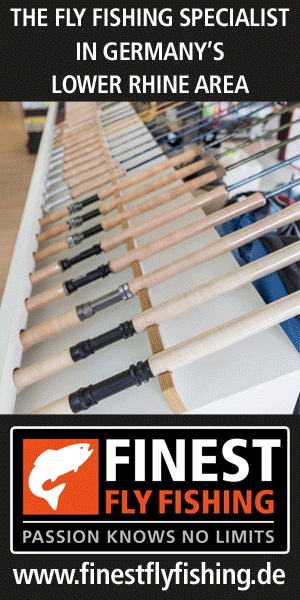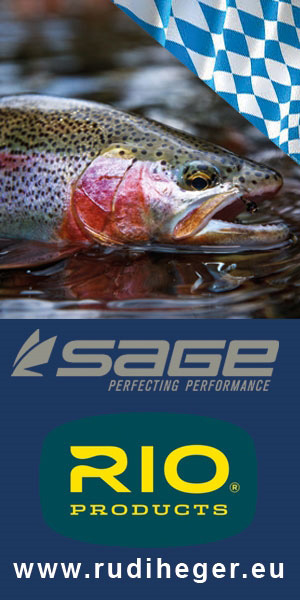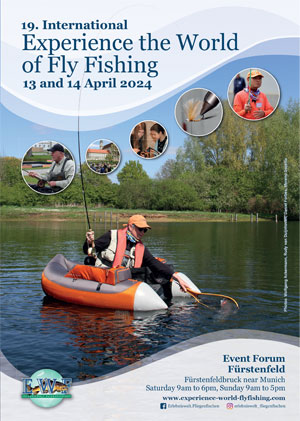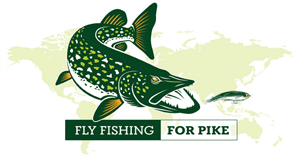
Don’t cast to the winds
With wind coming from the right, most flyfishers have, when they are right handed, problems with it. The fly and leader do hit the rod or our hat, damaging our rod or our selfconfidence. Still there is an easy solution for this problem, although I didn’t mean turning round and casting with your back to the water… Normally we cast with our rod held at an angle to the right, some people will drop the rodtip even further to the right, but this does not bring an improvement.
What we need to do is to hold our rod perfectly vertical or even with the rodtip above our left shoulder. From than on the wind will push line, leader and fly away from the rod instead of against it. In this way we can continue casting without having to bother with the wind or the cost of a new rod. The often thin rodblanks in use these last few years are easily damaged by a (weighted) fly travelling at topspeed. It may not break at that point immediately, but it will one day when you least expect it.
When the wind is blowing in our face, we have got other problems, mainly to reach enough distance. Here is where the narrow loop comes into play (although we need it for greater precision too), the front of a narrow loop will have less windresistance than a wide loop.
We achieve a narrow loop by keeping a small angle between the rods positions on the forward- and backcast. Whenever this angle is smaller than, lets say, 75 degrees we should get a narrow loop. When we keep our rod’s movements between the 10.30 or 11 and 1 o’clock positions we are keeping a small angle. We can still move the rod forward and backward without opening up that angle!

Without the help of the linehand we can only cast a limited length of line. Beyond that the loop becomes wider, the line starts to wave and we loose control over it all. When we transfer the energy we use in the rodhand to the linehand and give a pull on the line at every acceleration we make with the rod, we can greatly increase the speed of the line in the air.
After every strip we have to move our linehand immediately back towards the first ring on the rod. Only than can we strip again on the next cast. This is a contradictory movement, not that easy to learn but of great help every day we are out on the water. To learn this technique start by pressing the flyline against the rodhandle. While casting hold a constant length of line tight between the handle and linehand. This means the linehand has to follow the rodhand all the time.
Release the line at the handle but now keep a tight line between the first guide on the rod and the linehand. Later the contra-movement is than build into it, first on one of the casts perhaps, finally on both forward- and backcast. It is difficult to learn this from an article, but there are some video’s that should be helpful in mastering this technique.
Distance comes from the left
Once we have become used with double hauling, we will notice that when using this technique the rodhand almost only needs to give the right direction to our cast. It is even possible to cast a considerable length of line without the use of a rod! And when we do not put too much energy in the rodhand, our angle of the rodpositions can stay small, thus giving us a smaller loop and still greater distances. And now we can also cast a good way into the wind, not by applying extra power but by speeding up the flyline.

When we move our linehand forward on the backcast and down, past our hip on the forwardcast we use the most effective way of double stripping. Not some week pulls but energetic to give the line maximum speed, if necessary. Ones again: most energy is not passed on by the rodhand but by the linehand.
We most certainly need this technique when using a shootinghead, if we want to reach any distance with it. We loose control of the shootinghead when it is more than a yard orso from the tip of the rod. The thin runningline can not transfer enough energy to the heavier shootinghead to keep in control of it. So on the last forwardcast aim a little higher than usual, strip down past your hip with full speed and release the runningline immediately. A great length of runningline will be pulled along by the shootinghead.
Also when sidecasting we need a greater linespeed as the fly is travelling closer to the water or bottom. Keep the tip of your rod parallel to the water during the casting. When it is not moved in this way, the fly will often hit the water, in that way disturbing our quarry and we lose control over line and fly.
The Gebetsroither-style
The Austrian-style, as it is also called, has the name to be a style of casting for short stiff rods, which is not so. I also practise it with a slow rod for a three weight line, aswell as rods in the 9 and 10 foot range.

In the English-style of casting the fly goes down on the end of the backcast. When casting from the shoulder we now aim to make an ellips with the elbow, this makes for the line to travel below the rodtip on the backcast, but upwards behind us (!). On the forwardcast the line travels over the rodtip again as in the English-style.
What are the other advantages of this style of casting? It is a more effective way of casting, we need less energy to reach the same distance. Normally the rodtip travels a path that looks like part of a circle. By making that ellips with the elbow the rodtip follows a straight line and as most of you will imagine that results in it that less effort is necessary to reach a certain distance with the line.
Also with this style, as the line travels by a somewhat greater speed, less time is necessary to bring out the flyline and the effect of the wind on the line is less too. Whether there is any more information available on this style of casting in the English language on the internet at the moment, I do not know but I expect it is.
Try and learn
Whenever you have the chance to try out new rods and lines, do so. Whether it be at a show or your local water, with every cast the experience expands. Take a close look whenever a ‘pro’ is giving demonstrations and ask him whatever you want to know. Videos can be a great help to improve one’s style, not only the castingvideo’s that are available, but if you see yourself casting on a computer screen, possibly in slowmotion, it is easier to find certain mistakes. Use a light line against a dark background (edge of the wood) for you to be able to follow the line later. A lightly coloured line is invisible against the sky.
As an instructor at many flyfishingcourses I have certainly learned a lot from the questions people ask me. They made me think of matters I had never thought of before. So the teachers are still learning too, which is excellent I think.







